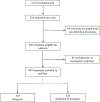Perceived value drives use of routine asymptomatic surveillance PET/CT by physicians who treat head and neck cancer
- PMID: 31919944
- PMCID: PMC7654549
- DOI: 10.1002/hed.26071
Perceived value drives use of routine asymptomatic surveillance PET/CT by physicians who treat head and neck cancer
Abstract
Background: Why physicians use surveillance imaging for asymptomatic cancer survivors despite recommendations against this is not known.
Methods: Physicians surveilling head and neck cancer survivors were surveyed to determine relationships among attitudes, beliefs, guideline familiarity, and self-reported surveillance positron-emission-tomography/computed-tomography use.
Results: Among 459 responses, 79% reported using PET/CT on some asymptomatic patients; 39% reported using PET/CT on more than half of patients. Among attitudes/beliefs, perceived value of surveillance imaging (O.R. 3.57, C.I. 2.42-5.27, P = <.0001) was the strongest predictor of high imaging, including beliefs about outcome (improved survival) and psychological benefits (reassurance, better communication). Twenty-four percent of physicians were unfamiliar with guideline recommendations against routine surveillance imaging. Among physicians with high perceived-value scores, those less familiar with guidelines imaged more (O.R. 3.55, C.I. 1.08-11.67, P = .037).
Conclusions: Interventions to decrease routine surveillance PET/CT use for asymptomatic patients must overcome physicians' misperceptions of its value. Education about guidelines may modify the effect of perceived value.
Keywords: PET/CT; head and neck cancer; physician decision-making; surveillance imaging; value.
© 2020 Wiley Periodicals, Inc.
Conflict of interest statement
CONFLICT OF INTEREST
The authors report no other financial disclosures or conflicts of interest.
Figures




Similar articles
-
Guideline familiarity predicts variation in self-reported use of routine surveillance PET/CT by physicians who treat head and neck cancer.J Natl Compr Canc Netw. 2015 Jan;13(1):69-77. doi: 10.6004/jnccn.2015.0010. J Natl Compr Canc Netw. 2015. PMID: 25583771
-
Update on 18F-fluorodeoxyglucose/positron emission tomography and positron emission tomography/computed tomography imaging of squamous head and neck cancers.Semin Nucl Med. 2005 Oct;35(4):214-9. doi: 10.1053/j.semnuclmed.2005.05.001. Semin Nucl Med. 2005. PMID: 16150243 Review.
-
PET-CT surveillance versus neck dissection in advanced head and neck cancer.Br Dent J. 2016 May 13;220(9):449. doi: 10.1038/sj.bdj.2016.327. Br Dent J. 2016. PMID: 27173700
-
Use of Diffusion-Weighted Imaging and 18F-Fluorodeoxyglucose Positron Emission Tomography Combined With Computed Tomography in the Response Assessment for (Chemo)radiotherapy in Head and Neck Squamous Cell Carcinoma.Clin Oncol (R Coll Radiol). 2018 Dec;30(12):780-792. doi: 10.1016/j.clon.2018.09.007. Epub 2018 Oct 11. Clin Oncol (R Coll Radiol). 2018. PMID: 30318343
-
Clinical Practice in PET/CT for the Management of Head and Neck Squamous Cell Cancer.AJR Am J Roentgenol. 2017 Aug;209(2):289-303. doi: 10.2214/AJR.17.18301. AJR Am J Roentgenol. 2017. PMID: 28731808 Review.
Cited by
-
The Value of Surveillance Imaging of Oral Squamous Cell Carcinoma.Cancers (Basel). 2024 Jan 1;16(1):207. doi: 10.3390/cancers16010207. Cancers (Basel). 2024. PMID: 38201635 Free PMC article.
-
Does Long-Term Surveillance Imaging Improve Survival in Patients Treated for Head and Neck Squamous Cell Carcinoma? A Systematic Review of the Current Evidence.AJNR Am J Neuroradiol. 2025 Jan 8;46(1):153-159. doi: 10.3174/ajnr.A8392. AJNR Am J Neuroradiol. 2025. PMID: 38914430
References
-
- Nekhlyudov L, Lacchetti C, Davis NB, et al. Head and neck cancer survivorship care guideline: American Society of Clinical Oncology clinical practice guideline endorsement of the American Cancer Society guideline. J Clin Oncol. 2017;35(14): 1606–1621. - PubMed
-
- National Comprehensive Cancer Network. NCCN Guidelines for Treatment of Cancer by Site. Available from URL: http://www.nccn.org/professionals/physician_gls/f_guidelines.asp-site.
-
- American Society of Clinical Oncology. Choosing Wisely: 10 Things Physicians and Patients Should Question; Item #8. Available from URL: http://www.choosingwisely.org/doctorpatient-lists/american-society-of-cl....
-
- Keating NL, Landrum MB, Guadagnoli E, Winer EP, Ayanian JZ. Surveillance testing among survivors of early-stage breast cancer. J Clin Oncol. 2007;25(9):1074–1081. - PubMed

